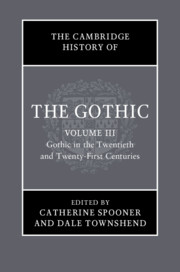Book contents
- The Cambridge History of the Gothic
- The Cambridge History of the Gothic
- The Cambridge History of the Gothic
- Copyright page
- Contents
- Figures
- Notes on Contributors
- Acknowledgements
- Introduction: A History of Gothic Studies in the Twentieth and Twenty-First Centuries
- 3.1 Gothic and Silent Cinema
- 3.2 Gothic, the Great War and the Rise of Modernism, 1910‒1936
- 3.3 Gothic and the American South, 1919‒1962
- 3.4 Hollywood Gothic, 1930–1960
- 3.5 Gothic and War, 1930‒1991
- 3.6 Gothic and the Postcolonial Moment
- 3.7 Gothic and the Heritage Movement in the Twentieth and Twenty-First Centuries
- 3.8 Gothic Enchantment: The Magical Strain in Twentieth and Twenty-First-Century Anglo-American Gothic
- 3.9 Psychoanalysis and the American Popular Gothic, 1954–1980
- 3.10 Gothic and the Counterculture, 1958‒Present
- 3.11 Gothic Television
- 3.12 Gothic and the Rise of Feminism
- 3.13 Gothic, AIDS and Sexuality, 1981–Present
- 3.14 The Gothic in the Age of Neo-Liberalism, 1990‒Present
- 3.15 The Gothic and Remix Culture
- 3.16 Postdigital Gothic
- 3.17 Gothic Multiculturalism
- 3.18 Gothic, Neo-Imperialism and the War on Terror
- 3.19 Global Gothic 1: Islamic Gothic
- 3.20 Global Gothic 2: East Asian Gothic
- 3.21 Global Gothic 3: Gothic in Modern Scandinavia
- 3.22 Gothic in an Age of Environmental Crisis
- 3.23 Gothic and the Apocalyptic Imagination
- Select Bibliography and Filmography
- Index
3.23 - Gothic and the Apocalyptic Imagination
Published online by Cambridge University Press: 29 July 2021
- The Cambridge History of the Gothic
- The Cambridge History of the Gothic
- The Cambridge History of the Gothic
- Copyright page
- Contents
- Figures
- Notes on Contributors
- Acknowledgements
- Introduction: A History of Gothic Studies in the Twentieth and Twenty-First Centuries
- 3.1 Gothic and Silent Cinema
- 3.2 Gothic, the Great War and the Rise of Modernism, 1910‒1936
- 3.3 Gothic and the American South, 1919‒1962
- 3.4 Hollywood Gothic, 1930–1960
- 3.5 Gothic and War, 1930‒1991
- 3.6 Gothic and the Postcolonial Moment
- 3.7 Gothic and the Heritage Movement in the Twentieth and Twenty-First Centuries
- 3.8 Gothic Enchantment: The Magical Strain in Twentieth and Twenty-First-Century Anglo-American Gothic
- 3.9 Psychoanalysis and the American Popular Gothic, 1954–1980
- 3.10 Gothic and the Counterculture, 1958‒Present
- 3.11 Gothic Television
- 3.12 Gothic and the Rise of Feminism
- 3.13 Gothic, AIDS and Sexuality, 1981–Present
- 3.14 The Gothic in the Age of Neo-Liberalism, 1990‒Present
- 3.15 The Gothic and Remix Culture
- 3.16 Postdigital Gothic
- 3.17 Gothic Multiculturalism
- 3.18 Gothic, Neo-Imperialism and the War on Terror
- 3.19 Global Gothic 1: Islamic Gothic
- 3.20 Global Gothic 2: East Asian Gothic
- 3.21 Global Gothic 3: Gothic in Modern Scandinavia
- 3.22 Gothic in an Age of Environmental Crisis
- 3.23 Gothic and the Apocalyptic Imagination
- Select Bibliography and Filmography
- Index
Summary
This chapter examines Gothic versions of apocalypse in the twentieth and twenty-first centuries. Apocalypse in its biblical forms is associated both with divine revelation and with the imagining of social and political transformation. Gothic apocalypses adopt the visionary and revelatory aspects of biblical apocalypse, but do so in order to imagine bleak futures, whether in the cosmic chaos of Weird fiction or in the more secular-materialist anxieties of political corruption, nuclear destruction, or economic and environmental collapse. The returned dead of Gothic fictions hint at the resurrected body in Christian eschatology, but here emptied of redemptive possibility: the body returns not in the likeness of the risen Christ, but in the monstrous form of the zombie, vampire or revenant. Yet if Gothic apocalypses often depict the dehumanisation of the human and the collapse of the modern political and economic order, their visions of catastrophe also open space for the exploration of new ways of being on the other side of the end. Confronting contemporary anxieties around ecological destruction and economic crisis, Gothic apocalypses in the twenty-first century offer tentative glimpses of renewal in a remade world.
Keywords
- Type
- Chapter
- Information
- The Cambridge History of the GothicVolume 3: Gothic in the Twentieth and Twenty-First Centuries, pp. 465 - 482Publisher: Cambridge University PressPrint publication year: 2021

